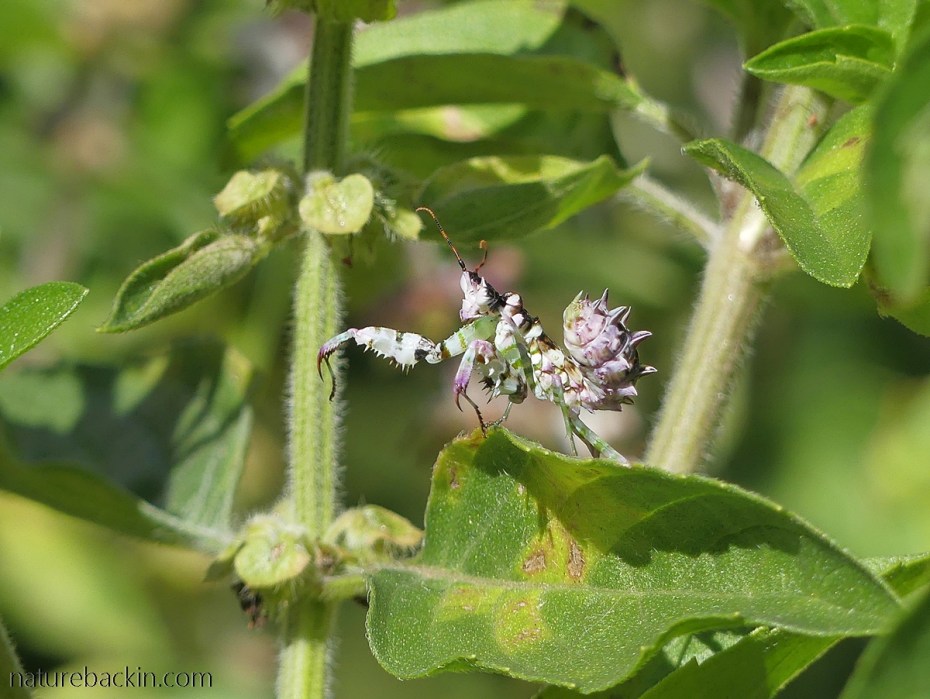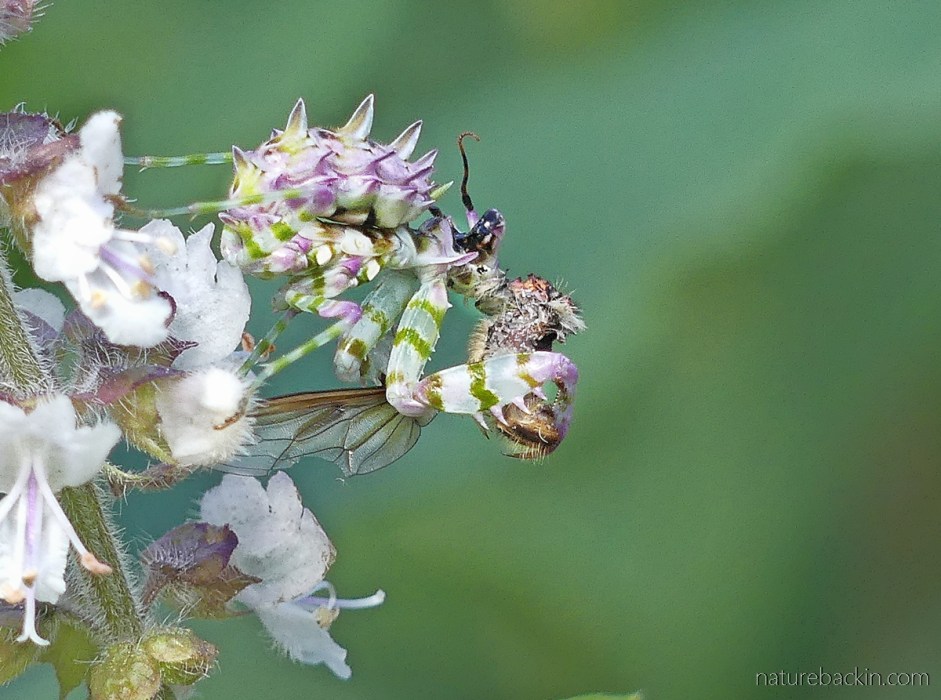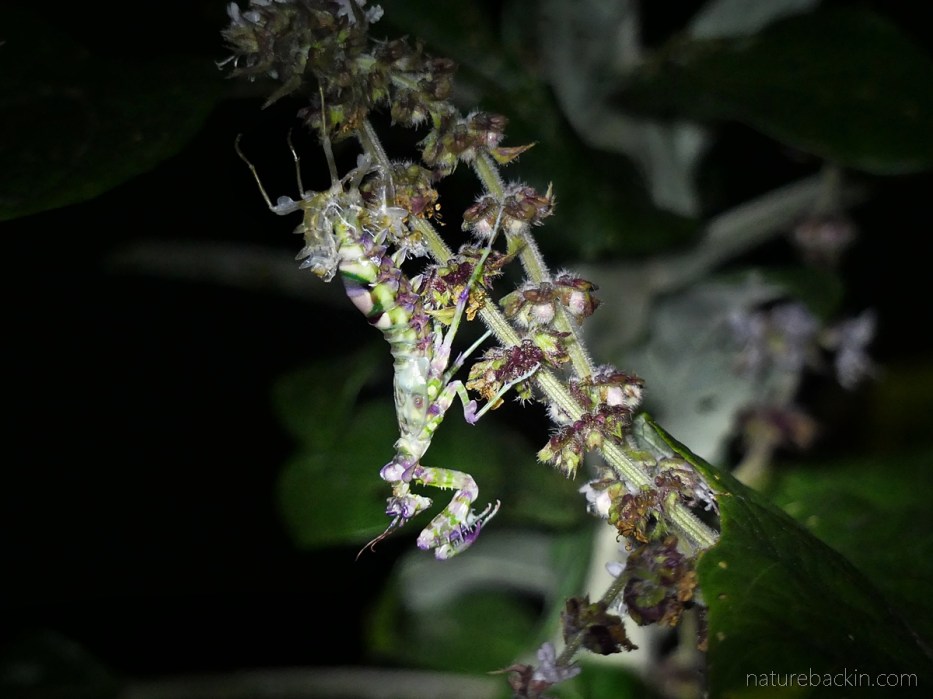From March to July this year we were able to observe several spiny flower mantid nymphs in the basil bush in our herb garden. The basil bush was their home and hunting ground for four months as they developed towards adulthood.
I previously posted about them in April, see here, and this is an update from then until the end of July when I took my last photograph of a spiny flower mantid (Pseudocreobotra wahlbergi) in the basil bush. To give some impression of how the mantids developed and grew in size, below is a photo of a tiny mantid nymph taken on 29 March 2021, and below that a photo of much larger and more developed nymph taken on 4 July 2021.

This spiny flower mantid nymph was very tiny and easy to overlook

Thirteen weeks later, this nymph is considerably larger and more robust. The eye spots on the wings are becoming apparent. There is also a dorsal eye spot that can only been seen when the mantid straightens its abdomen that it carries curled up during its various stages as a nymph
Mantid nymphs go through several moults to reach adulthood – seven for females and six for males – and I would guess that the nymph in the photo above has only one or two more moults to go to reach adulthood. At the final moult into adulthood the mantid’s wings are fully developed and they are then able to fly. The eyes spots on the wings can be used to frighten off predators – if threatened the adult mantid can spread its wings to display the eye spots, one on each wing.

I fancy that the mantids in the basil bush got quite used to us observing them. This one turned to look at me as I approached with my camera
Mostly the mantids were quite sedentary. In the early mornings they would often sun themselves, moving into shade as the sun got hotter. In the early mornings I would sometimes see them climbing up flower stems to be near the top where they would turn and face downwards, which seemed to be their favourite hunting posture. I did not spend time watching them at night, but I expect that they would remain active hunters at night, although even then they would likely be sedentary hunters, ambushing unsuspecting insects that visited the flowers to feed.

When the mantids do move around to climb to a hunting perch, for example, they can climb quite quickly often flicking or wagging the upturned abdomen as they climb and revealing their surprisingly long legs
On some mornings I watched mantids apparently hunting each other. Once, when hiding behind leaves did not deter pursuit, I saw one mantid that was in danger of being caught jump off the plant and drop to the ground and successfully evade capture.

This mantid was first keeping an eye on and then actively pursuing another mantid of similar size as it was climbing to its hunting perch

Some of the mantids were more stripey and colourful than others. In this photo the length and strength of the spiny forelegs that are used to catch and grasp prey can be seen

This mantis is tucking into its catch. I mostly saw them eating flies, but I also saw them eating honey bees and sometimes small butterflies, and once a katydid. I also saw them attempting to catch hoverflies and solitary bees

This mantid is eating a bee that it is grasping firmly with its forelegs as it eats, biting off chunks and chewing with what appears to be considerable relish

Even though I kept an eye out to see if I could see any mantids moulting, I only saw it twice. Once in late March as featured in the previous post on mantids, and once one evening after dark in mid June. I went outside with a torch to pick some herbs and flicked the torch towards the basil bush and saw this mantid just completing its moult. The dorsal eye spot is visible as the abdomen is straightened out while moulting and the eye spots on the budding wings are also starting to show. The just-shed exoskeleton can be seen at the tail end of the mantid

This mantid is well-developed enough so that the eye spots on the wings can clearly be seen
I have put together a short video of some of the clips that I took of the mantids during the 4 months they spent growing up on our basil bush. The video gives one a better idea of how they move with their rather odd posture with the abdomen curled up, and also shows their climbing ability. It also shows a mantid attempting to actively hunt a butterfly rather than relying on the more usual technique of waiting for an insect to pass by within reach of their extraordinary long forelegs.
At any one time the most mantids we counted on the basil bush was eight. There was some variation is size, perhaps as some were more successful hunters than others. Although I missed seeing them after they had all departed – I never saw an adult as I suppose they simply flew away after they had recovered from their final moult – in a way it was a relief to be able to see pollinators at the basil bush without fearing for their lives ending in the clutches of a hungry mantid.

Posted by Carol









October 24, 2021 at 4:39 am
You do have some of the weirdest critters I’ve ever seen. That video sure helped to show how they move (a bit creepy, actually!) It’s always a pleasure being educated and entertained here!
LikeLiked by 1 person
October 24, 2021 at 7:58 pm
Mantids are kind of weird anyway, but add the elaborate spines and colourful camouflage, and these ones are weirder still!
LikeLike
October 21, 2021 at 1:11 am
What a fascinating creature! They looked robotic and sometimes very human to me…..something that you might see working in a factory for miniature items.😊😊
What I also found really fun was the bird or creature noises in the background. It sounds like you live in a lively place!
Julie
LikeLiked by 1 person
October 21, 2021 at 8:04 pm
I agree that somehow they can look both robotic and surprisingly human at times. In my imagination I can see them as tiny factory workers in a tiny factory 😊
Yes we do live with a lively birdcall soundtrack going on around us. Unfortunately some of the video clips also picked up the occasional sound of my husband mixing paint!
LikeLiked by 1 person
October 17, 2021 at 8:26 am
Fascinating Carol. I am in awe for your patience and tenacity 😉
LikeLike
October 18, 2021 at 8:23 pm
Thanks Anne – they certainly were very fascinating to keep an eye on and watch their progress.
LikeLike
October 16, 2021 at 10:02 am
They look like creatures from another planet! Thank you for bringing them to our attention through your patient observations and clever camera work
LikeLiked by 1 person
October 18, 2021 at 7:51 pm
Thanks Mariss. I wonder when we might next come across any in the garden.
LikeLiked by 1 person
October 15, 2021 at 4:29 pm
They really are quite something, aren’t they? No wonder you’ve followed them with such interest.
LikeLiked by 1 person
October 15, 2021 at 7:50 pm
We found them quite mesmerizing, although when lots of pollinators were flitting around I often turned away rather than watch the hunt and the sadly sticky end for a pollinator unlucky enough to be caught …
LikeLiked by 1 person
October 16, 2021 at 7:47 am
Oh yes. Red in tooth and claw ain’t pretty.
LikeLiked by 1 person
October 15, 2021 at 9:43 am
Simply amazing. Thank you, Carol.
LikeLiked by 1 person
October 15, 2021 at 7:46 pm
Thanks Sandra – yes they are amazing little creatures.
LikeLiked by 1 person
October 15, 2021 at 7:02 am
Such stunningly beautiful creatures, and masterfully depicted too, Carol!
Fascinating as always and I cannot begin to express how grateful I am for all the time and trouble you put into each of your posts.
LikeLiked by 1 person
October 15, 2021 at 7:45 pm
They are very beautiful and challenging to photograph as they are so small and well-camouflaged. This post has been percolating on a back burner for some time! Thank you for your kind comment.
LikeLiked by 1 person
October 15, 2021 at 4:57 am
You are an awesome photographer, inordinately patient, and a born educator. This is a marvellous post, Carol!
LikeLiked by 1 person
October 15, 2021 at 7:37 pm
Thanks so much for your very generous comments Anne. They are such intriguing little creatures that it was nice to be able share my photos and observations.
LikeLiked by 1 person
October 15, 2021 at 4:34 am
I’m wildly jealous of your having flower mantids in the garden. They look so other-worldly. One has to look closely at the photos to distinguish them. Loved the video too.
LikeLiked by 1 person
October 15, 2021 at 7:34 pm
It is not often that I see them and to have 8 in one small bush was amazing. There is something other-worldly about them and they look so knowing despite their tiny size. We were so drawn to them that we checked up on them almost every day.
LikeLiked by 1 person
October 16, 2021 at 5:36 am
It’s great that you were able to follow their development.
LikeLiked by 1 person
October 15, 2021 at 12:00 am
Such fantastical creatures! I loved the video enabling us to see its jittery motions, and cocked tail bobbing– a curious little insect. Great post, Carol.
LikeLiked by 1 person